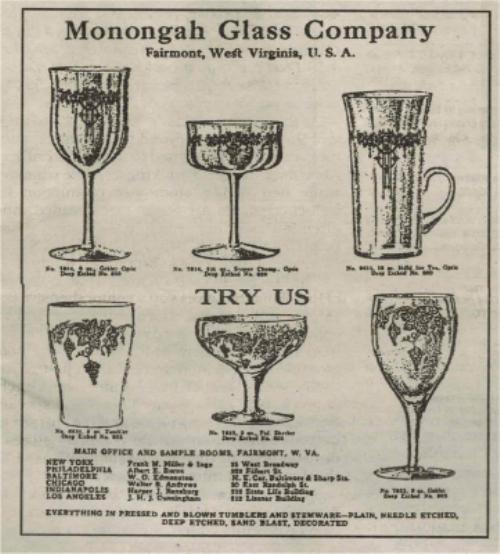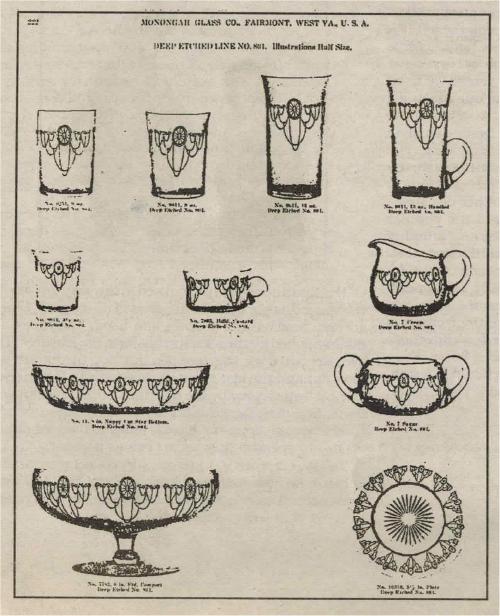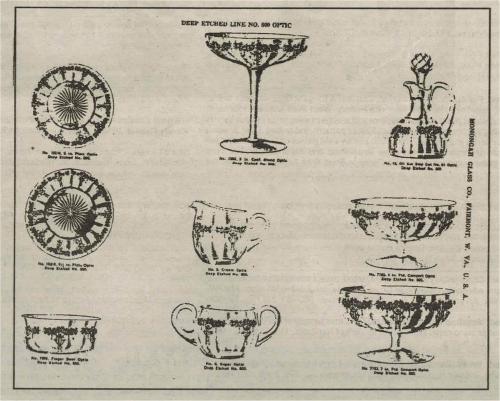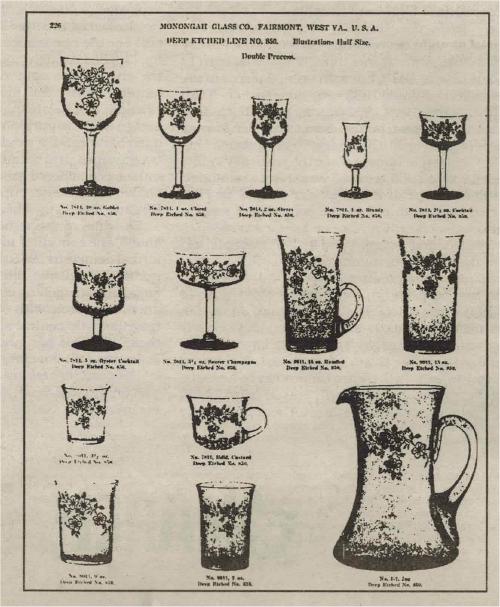National Depression Glass Association
Preserving America's Glass Manufacturing Heritage
Monongah Glass: Forgotten Glass Giant
by Dean Six
From the Daze, March 1996
As I continue to chase the over 450 West Virginia glass companies operating since the early 1800s, some companies just seem to haunt me. Monongah Glass of Fairmont, WV, has been haunting me for several years. Briefly, Monongah began operation in August 1904 in an immense and new factory. They grew and acquired other glass factories in the same city, having at least three separate factories at one time. In 1908, Monongah made 12,000 dozen (that's 144,000) glass articles every 24 hours. Thus, I deem them a "Glass Giant." By 1928, their success had made them vulnerable for takeover by the huge Collin—Hocking glass empire and Monongah ceased to exist as a company. The Fairmont plant was closed circa 1933.
However, in the three decades immense quantities of quality glass, including lead stemware, was made. Weatherman II shows a good variety of color, shapes, and decorations. I cannot help but point out that a 1910 advertisement shown in Harry Northwood: The Wheeling Years by James Measell illustrates fine cut Monongah Glass as the top of the page (and thus top line) and less expensive pressed Northwood glass below. How different our perception is today!
An abbreviated look at Monongah patterns includes two that are most distinguishable: Springtime was the plate etched with acid line that later was adapted to become Hocking's very recognized machine made Cameo line. Remember, Springtime is handmade, thin and acid etched. In Springtime the dancing nymph always faces left and colorless glass is most often found. Cameo is a heavier and machine formed line where the nymph has been turned to face always to the right. One wonders why this change in direction?
The second most identified Monongah line is probably their design 854, which the factory titled Bo-Peep. This "cute" plate etching is very difficult to find. I see it most on pink blanks, but amber stems with colorless bowls are found. The original catalog pages indicate it was made colorless with green stems, feet, handles, etc., and in all pink. From finger bowls to covered jug and salad plate, one could, theoretically, set a table in Bo-Peep!
I suggest that the most easily found Monongah pattern of interest to elegant Depression-era collectors is their pattern Deep Etch no. 800, which Mrs. Weatherman titled Roseland. It was produced at least as early as 1915, evidenced by the ad shown here. Their "Supplement No. 1 to Catalog No. 5" bears the date January 1,1916 and has 38 pages. Three of those pages show Roseland on 35 different shapes. It is my belief that in these early years, only colorless blanks were used. Roseland remains an active line in Monongah's Catalog No. 6 dated April 1 , 1920 where it appears on page 218. Later, Roseland was made in pink; at least I have found a single example to date. I would be excited to hear of colored Roseland pieces.
Of the dozens identified and confirmed Monongah patterns to date, I wish to share a few not previously published to my knowledge. Their line 801 is a graceful swag and I suggest the name "Heintzelman" for reference to this pattern, named honoring the company founder and president. It is shown on several pages in the catalog but I have yet to hold a single piece of it. Monongah's Line 850 was made, as perhaps most of their successful lines were, in over 30 shapes. This pattern is an etching using two different plates and etched twice. allowing for two different textures in the design. An elegant blossom, this pattern has been shared with me by two families whose mothers worked in Monongah's office prior to marriage. Honoring those ladies, this pattern had been locally dubbed "Secretary's Primrose." As you can now imagine, much great unidentified glass of the "elegant" period can be attributed to Monongah.
Webmaster's NOTE: This article was taken from the March 1996 edition of the Daze. The author, Dean Six, is currently the Executive Director of the Museum of American Glass located in Weston, WV. He was a semi-regular contributor to the Daze during its time of publication.



